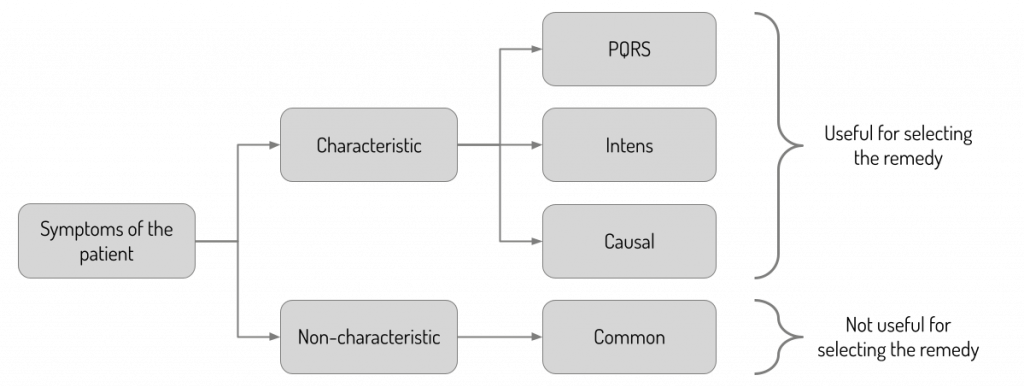Introduction
Totality is a concept characteristic of classical homeopathy. It implies that we don’t focus solely on the symptoms associated with a particular diagnosis or ailment but rather on the symptoms of the entire patient. However, it’s not literally all symptoms that are used to find the appropriate remedy but primarily those that are characteristic of the individual patient. We primarily use the patient’s characteristic symptoms, which include PQRS, intense, and causal symptoms. The rest are non-characteristic symptoms. Based on these characteristic symptoms, we select a potentized remedy that best fits the individual patient. This is called the simillimum.
Symptoms of the entire patient

In principle, a classical homeopath uses the patient’s symptoms as a whole and not just the symptoms associated with a specific ailment or diagnosis. Samuel Hahnemann describes this in paragraph 18 of the ‘Organon’ as follows:
‘Apart from the totality of symptoms – which is an undeniable truth – taking into account additional circumstances (see § 5), nothing else can be discovered about diseases that could provide therapeutic indications. It is therefore undeniable that the totality of all symptoms and circumstances observed in each individual case of disease must be the only indication that can lead to the choice of a remedy.’
In other words, when selecting an appropriate homeopathic remedy, we focus primarily on the symptoms of the individual patient rather than only those symptoms related to a particular diagnosis or disease.
Selection of symptoms to determine a homeopathic remedy
If a classical homeopath were to use all the patient’s symptoms, finding an appropriate remedy would be nearly impossible. So, Hahnemann nuanced it. When searching for the appropriate remedy, we do not use all the patient’s symptoms. We primarily use the symptoms that are characteristic of the individual patient. Samuel Hahnemann described this idea in paragraph 153 of the ‘Organon’ as follows:‘In searching for a homeopathically specific remedy, one must compare the totality of the natural disease’s symptoms with the symptom sequences of the available medicines to choose an artificial disease agent that matches the disease to be cured. In doing so, one must pay particular attention to the more striking, strange, unusual, and characteristic symptoms and signs of the case. These must especially correspond with the symptoms of the remedy sought if that remedy is to be the most suitable for healing.’Hahnemann always wrote very precisely, but unfortunately, also a bit convoluted. The above quote is a translation of the original German text from the 19th century. In short, he says that we should mainly use the characteristic symptoms of the natural disease to find an appropriate remedy. He uses the German term ‘Inbegriff’, which means the most important, the personification, or the embodiment. This word is usually translated as ‘totality’ in English. This translation leads to the misconception that all symptoms must be used to find the appropriate remedy. However, that’s not the case. A classical homeopath primarily focuses on the characteristic symptoms typical of the individual patient.

Characteristic: PQRS
The term PQRS stands for ‘peculiar, queer, rare, strange’. It refers to symptoms that cannot be explained by the context and are therefore indicative of the patient. For example: someone always has a headache on the right temple (and never on the left) or has a fever spike consistently around 9:00 p.m. In the article ‘What is a symptom according to classical homeopathy?’ we delve deeper into this topic.
Characteristic: Intense
Intense symptoms are peculiar because they are out of proportion. They are symptoms that can be explained on their own, but the reaction is disproportionate compared to what you would expect in the situation. For example: a headache can occur because you were exposed to the hot sun for too long. However, if you get a severe headache after relatively brief exposure to the sun, this is explainable, but the reaction is disproportionate compared to what you would expect. In the article “What is a symptom according to classical homeopathy?” we delve deeper into this concept.
Characteristic: Causal
Lastly, causal symptoms are also peculiar symptoms. The characteristic or unusual aspect is that there is no recovery after a certain experience or situation that happened in the past, while you would expect recovery by now. An example of this is someone who had a car accident a year ago and has had a headache ever since, although structurally nothing is wrong with the body. In that case, you would expect the body to have healed from the accident, but that hasn’t happened. In the article ‘What is a symptom according to classical homeopathy?’ you can read more about this concept.
Non-Characteristic
All other symptoms fall into this category. In other words, they are non-characteristic, non-distinctive, or ordinary symptoms. These symptoms are initially unsuitable for finding an appropriate remedy for an individual patient. They are explainable, proportional, and non-causal symptoms.
Symptoms versus diagnosis in classical homeopathy
To choose an appropriate remedy for a patient, we use the symptoms the patient displays. In short, symptoms are expressions of the natural disease.
We assume that someone is not sick at the level of cells or organs but as a whole. We have tried to explain this interesting idea in the article ‘What is disease according to classical homeopathy?’ The unique aspect of classical homeopathy is that we prescribe one appropriate remedy per patient and not one remedy per diagnosis or disease. This appropriate potentized remedy is called the simillimum.
In classical homeopathy, unlike conventional medicine, we do not use the diagnosis or name of a disease but rather the symptoms the patient is experiencing. While conventional medicine seeks a diagnosis to align therapy with, we use symptoms to find a remedy that has helped someone with a similar combination of symptoms in the past. Diagnosis has a different meaning in conventional medicine than in classical homeopathy. In conventional medicine, a diagnosis is the name of a disease often related to malfunctioning cells, an organ, or a system. In classical homeopathy, the diagnosis is the remedy that best fits the patient’s symptoms. From the perspective of classical homeopathy, the treatment focuses on the patient as a whole, not on a specific disease or organ or organ system.
Prescribing potentized remedies based on a medical diagnosis is known as clinical homeopathy. This methodology is essentially contrary to the basic principles of classical homeopathy and is therefore not something we support as an institution.
The concept of totality and training as a classical homeopath
On paper, the concept of totality and searching for the right symptoms is relatively easy to understand, but practice is often more challenging. For instance, there are gray areas, or the situation is complicated because patients use medication or are in certain circumstances, making it difficult to determine characteristic symptoms (i.e., totality). Even many homeopaths who have had a practice for a long time sometimes struggle to apply this concept in practice. Unfortunately, little attention is given to this important part of homeopathy in continuing education and even in some training courses today.
In our training, you learn very practically and extensively to apply the concept of totality to many cases. Throughout the course, we provide you with many tips and tools to determine totality. We try to give you practical guidance at the beginning of the training through many paper cases, and later during video cases and internships so that this ultimately becomes second nature. By actively studying and determining totality to find the appropriate remedy with a high degree of certainty, it becomes relatively easy.
Sources:
- Hahnemann, S. (1982). Organon of Medicine (W. Boericke, Trans.; 6th ed.). B. Jain Publishers.







